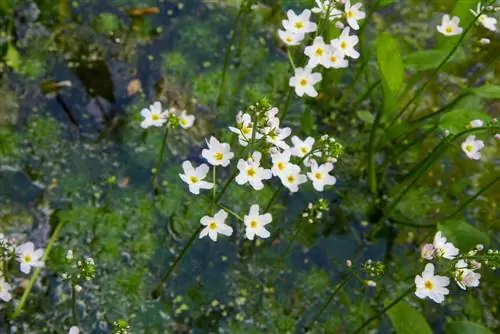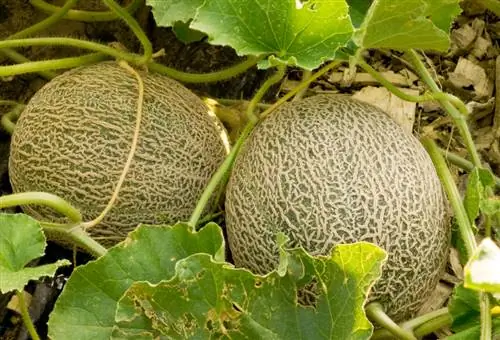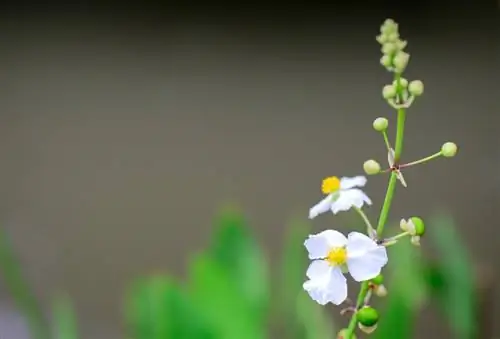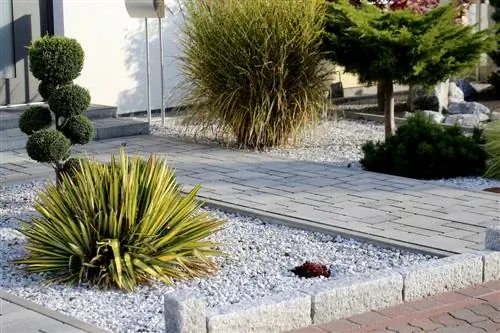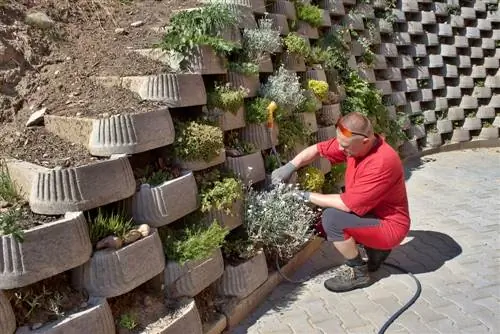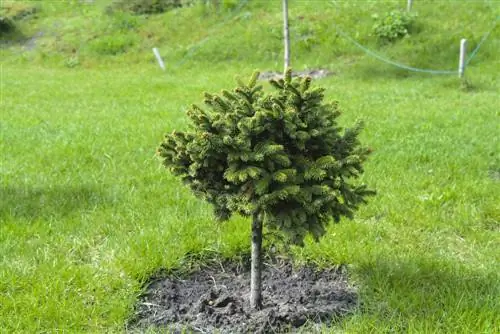- Author admin [email protected].
- Public 2023-12-16 16:46.
- Last modified 2025-01-23 11:22.
Read a commented frog spoon profile here with information about occurrence, growth and three native Alisma species. You can find out how to properly plant and care for the swamp and water plant here.
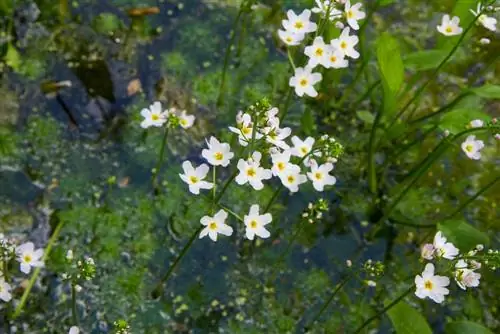
How to plant and care for frog spoon?
Frog spoon (Alisma) prefers sunny to partially shaded locations and nutrient-rich, swampy-loamy soils. Plant them in shallow water up to a maximum depth of 30 cm or in moist soil. Regular pruning and division promote their growth and prevent unwanted spread. Frog spoon is hardy and requires little care.
Profile
- Scientific name: Alisma
- Genus: Frog Spoon with 9 species
- Family: Frog spoon family (Alismataceae)
- Occurrence: Europe, Asia, North America
- Growth type: perennial marsh and aquatic plant
- Growth height: 20 cm to 100 cm
- Leaves: ovate to broadly lanceolate
- Flowers: panicles
- Roots: tuberous rhizomes
- Toxicity: poisonous
- Winter hardiness: hardy
- Use: Garden pond, water garden, stream
Occurrences
Frog spoons (Alisma) are an amphibious plant genus from the family of frog spoons (Alismataceae). The decorative marsh and aquatic plants are widespread worldwide in temperate and subtropical climate zones. In Central Europe, frog spoonbills often inhabit the bank areas of ponds, ponds, ponds and ditches. Native Alisma species prefer to thrive in stagnant and slow-flowing waters where the soil is nutrient-rich.
Growth
With their preference for amphibious locations, frog spoons are recommended for the creative design of garden ponds, streams and swampy water worlds. These key growth data explain why this is the case:
- Growth type: deciduous, herbaceous perennial as a rooting aquatic plant or swamp plant.
- Growth habit: upright, loosely clumpy with submerged water leaves, emersed, basal air leaves and long-stemmed, white to pink inflorescences in several tiers.
- Growth height: 20 cm to 100 cm.
- Growth width: 30 cm to 50 cm.
- Roots: tuberous rhizomes, sprouting tubers.
- Ghorticulturally interesting properties: hardy, easy to care for, robust, insect-friendly, water-purifying, runner-forming, grows wild through self-seeding, slightly poisonous.
Video: Real frog spoon - naturally beautiful in the garden kingdom
leaves
Native frog spoon forms two types of leaves that are characterized by these characteristics:
- Air leaves (emersed): basal, long-stalked leaf blade, broadly ovate, heart-shaped or lanceolate with smooth leaf margin.
- Water leaves (submerged): flooding, ribbon-like to grass-like.
- Leaf size: petiole 10-25 cm long, leaf blade 6-20 cm long, 1.5-12 cm wide.
- Leaf colors: fresh green to blue-green with clearly visible leaf veins.
Flowers
In summer, delicate inflorescences float above the basal leaf rosettes with these attributes:
- Inflorescence: upright, leafless stem up to 70 cm long with flower spikes arranged in tiers.
- Single flower: threefold, 3 green sepals (2-3 mm long), 3 white-pink petals (3-6 mm long), 6 stamens.
- Single flower size: 1-1.5 cm in diameter
- Flower ecology: hermaphrodite, homogamous pollen disc flower.
- Pollinators: predominantly hoverflies and other water-near insects.
- Flowering time: June to August
- Fruits: split fruits
The white to pink individual flowers are enthroned on a 1.5 to 3.5 cm long flower stalk and attract visits from pollinator insects. For this purpose, the stamens are equipped with basal nectar tissue as a reward for pollen transport. Split fruits form from pollinated flowers, which break down into floating fruits. The seeds contained therein are cold germinators and float on the surface of the water for up to 15 months.
Frog spoon species
From the cosmopolitan Alisma genus, these three interesting frog spoon species can be admired in the wild, in parks and garden ponds:
| Frog spoon species | Common Frog Spoon | Lancelet-leaved frog spoon | Heart-leaved frog spoon |
|---|---|---|---|
| Botanical name | Alisma plantago-aquatica | Alisma lanceolatum | Alisma parviflorum |
| Synonym | Real frog spoon | Lancet frog spoon | Heartleaf frog spoon |
| Leaf shape | broad-elliptical to ovoid | broad-lanceolate | heart-shaped |
| Growth height | 20 cm to 90 cm | 20 cm to 50 cm | 25 cm to 80 cm |
| Flower color | white to purple-pink | soft pink, blue-violet | light pink |
| Speciality | Flowers open at noon | Flowers open in the morning | Fruits decorate until winter |
Planting frog spoons
You can plant the common frog spoonbill and its native counterparts at any time, as long as the swampy ground is not frozen. The best time to plant is in spring so that the rhizomes can build up well until winter. Where and how to plant frog spoons correctly, read here:
Location, soil, water depth
These are the ideal conditions for naturally beautiful frog spoons:
- Sunny to partially shaded location.
- Swampy-loamy soil, nutrient-rich, humic, slightly acidic to neutral.
- Water depths: Shallow water up to a maximum depth of 30 cm (lanceolate frog spoon up to 10 cm water depth).
Extra tip: Common frog spoonbill (Alisma plantago-aquatica) tolerates temporary dry periods and is ideal for greening depressions with seasonal waterlogging.
Planting
For convenience, you can place frog spoons directly into the pond soil. Planting in a tightly meshed mesh pot is recommended so that the rhizomes do not spread uncontrollably. The following short instructions explain how to properly plant the perennial in the garden pond and stream:
- Put on gloves to protect yourself from the skin-irritating latex.
- Fill the pond basket two thirds full with aquatic plant substrate.
- Unpot the frog spoon from the sales pot.
- Lay rhizomes flat on the ground.
- Fill additional substrate up to the previous planting depth in the purchase container.
- Mulching with gravel as a top layer.
- Observe planting distance of 35 cm to 40 cm.
At the desired location, place the frog spoon in shallow water or in the swampy earth. If the planting site is 20 cm to 30 cm below the water surface, you should ideally proceed in stages. First place the pond basket on a platform made of stones or clean bricks. In proportion to the growth of the air leaves, remove a stone until the final water depth is reached.
Excursus
Subtropical frog spoon adds greenery to the aquarium
A frog spoon family comes from South America that makes aquarists' hearts beat faster. Argentine frog spoon (Echinodorus argentinensis) decorates the aquarium as a tropical, lush aquatic plant with elongated, egg-shaped leaves up to 50 cm long. The exotic frog spoon species thrives best in warm water with 18° to 28° Celsius and a pH value of 6.8 to 7.5. In cooler, hard water, the pretty perennial remains at a height of 25 cm to 30 cm.
Maintaining frog spoons
Frog spoon is undemanding. The following tips get to the heart of how to properly care for Alisma species.
Cutting
Frog spoon cut care is limited to these measures:
- Clean out wilted flowers before fruiting and unrestrained self-sowing.
- Cut off dead leaves with petioles at the base, remove clippings with a landing net.
- Cut off excessively long rhizomes or pierce them with a spade.
- Caution: Wear gloves before possible contact with the latex.
Share
Dividing the rootstock allows for easy propagation and limits the spread of the aquatic plant. The best time is in spring, as soon as the water and soil have thawed. Expose a recognizable runner, cut off the rhizome and plant it in the new location. Alternatively, dig up the perennial to cut the rhizome in half on a firm surface.
Wintering
Frog spoon is a hardy perennial and does not require any special protective measures. In autumn the leaves gradually fall in. During this process, nutrients are transferred from the green parts of the plant into the rhizomes as an energy reserve. The tuberous rhizomes themselves are frost hardy and survive the winter even in frozen pond water.
Propagate
Beyond vegetative propagation, you can propagate frog spoons by sowing. Specialist retailers offer certified seeds at reasonable prices. Alternatively, let the fruits ripen on some flower stalks in order to remove the seeds from the capsules. Stratification overcomes the germination inhibition of cold germinators. How to do it right:
- Fill the waterproof bowl with nutrient-rich mud soil.
- Press seeds into the moist substrate.
- Fill up to 1 cm high with collected rainwater.
- 2 to 4 weeks place bright and warm at 22° to 25° Celsius.
- Keep cool at 0° Celsius for another 4 to 6 weeks (water may freeze).
After the cold phase, the location heat is gradually increased to 20° to 22° Celsius. Young frog spoons with several leaves are strong enough for planting in the garden pond.
Diseases and pests
Frog spoons are very robust. However, the perennials are not completely immune to pathogens. An infestation by black aphids can be recognized by brown spots and sticky coating on the air leaves. Remove infected leaves to prevent the pests from spreading further.
Planting distances that are too small can cause smut fungus, caused by pathogens from a subdivision of the fungi (Basidiomycota). The damage caused by the brown air leaves is reminiscent of drought stress and sunburn. In fact, the aquatic plants suffer from a lack of oxygen. The easiest way to solve the problem is to divide and thin out the perennials.
Popular varieties
The natural beauty of the pure original species cannot be improved through breeding, so that no Alisma varieties are available in specialist shops.
FAQ
Are frog spoons poisonous?
Frog spoons are among the mildly poisonous aquatic plants. The reason for the assignment is a poisonous milky sap that is contained in all parts of the plant. Direct skin contact can cause annoying itching, redness and blistering. In addition, the rhizomes contain a toxic bitter substance and pungent essential oil. These ingredients cause nausea and vomiting when consumed intentionally or unintentionally.
Is a frog spoon hardy in a pond?
Froschlöffel is certified to have reliable winter hardiness down to -23° Celsius. After the first frost, the aquatic plant reduces to its sprouting tuber. The emersed and submerged leaves die. The rhizomes overwinter in frozen swamps and shallow water. The following spring the tubers sprout again with fresh leaves.
A frog spoon grows in the garden pond. What to do?
Over the years, a frog spoon can spread undesirably using its rhizomes. The expansion can be regulated with a division. The best time is in spring, shortly before budding. Dig up the offending perennial. Use a knife to cut the rhizome in half and cut off any excess rhizomes. Place a section in the boggy soil in a close-meshed plant basket. From now on, the plant basket serves as a root barrier.
What are good plant neighbors for frog spoons?
Combine frog spoons with native marsh and aquatic plants. Highly recommended are pink swan flowers (Butomus umbellatus), yellow marsh marigolds (C altha palustris) and narrow-leaved cattails (Typha angustifolia). Froschlöffel also maintains a harmonious neighborhood with blue-flowering stream bunting (Veronica beccabunga) and pink-flowering water knotweed (Persicaria amphibia).

